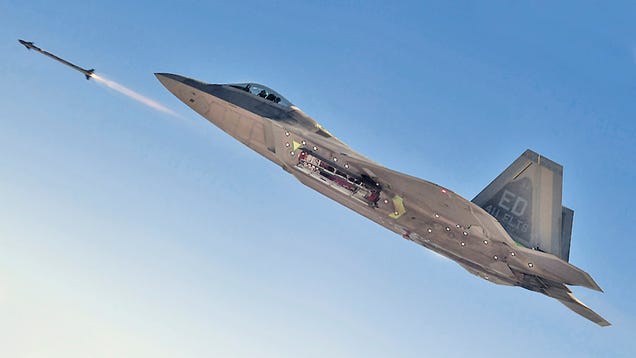
Posted on 05/18/2015 5:39:38 AM PDT by sukhoi-30mki

34 years ago, the USAF set out to build a fighter that could guarantee American air superiority for decades to come. $75B, 563 less aircraft than planned, and a decade after being declared operational later, the F-22 still doesn’t have what some MiG-21s have, a Helmet Mounted Sight and a missile to go with it.
Helmet Mounted Sights (HMS) and High-Off Bore-Sight (HOBS) short-range air-to-air missiles have been around for a long, long time. Helmet Mounted Sights, in their most basic form, allow pilots to just look at their target in order to slew their weapons onto it and engage it. HOBS air-to-air missiles allow for targets to be engaged far off the aircraft’s center-line by using a steerable, gimble-mounted seeker head.
The South African Air Force (SAAF) was the first to produce and fly with a fairly crude version of a HMS in the 1970s aboard their Mirage F1s fighters, along with their indigenously developed V3B HOBS short-range air-to-air missile.
Meanwhile the US Navy saw the potential in such a concept and tested Honeywell’s Visual Target Acquisition System over a four year period between 1974 and 1978 as part of a larger evaluation of what the future of air-to-air combat could look like. Although the tests were largely successful, nothing more came of the test program aside from a limited number of older F-4 Phantoms continuing to fly with the system for a limited time.
uring the “Border Wars” between Angola and South Africa in the early 1980s, the HMS and HOBS missile proved deadly for Soviet fighters flown by the Angolan forces. Russia took notice and started a high-speed development program to bring HMS and HOBS missile technology to their latest fighter designs. The result was a monocle-like Helmet Mounted Sight syst
(Excerpt) Read more at foxtrotalpha.jalopnik.com ...
#Because Lockheed
That and a Clint Eastwood movie.
This December the Sidewinder celebrates its first kill, 50 years ago.
Just sayin’...
Nothing came of the Honeywell helmet sight because Honeywell early retired all the engineers on the project back in the late 90’s
I saw the prototype
I was working on this 20 years ago. Its very frustrating the the U.S. hasn’t universally fielded helmet mounted sights.
I can see an issue with the bay mounted missiles in the F-22 and F-35 as the fully gimballed seeker can’t look through the airframe to sync with the off axis sight, but that is another matter.
And whatever happened to fighter designations 24-31 and 33-34? Yes, I know some X-planes used those numbers, but most are out of sequence in their timing and the X-22 has nothing to do with the Raptor, although a few X designations do correspond to developmental aircraft. Designations haven’t made any sense for 30 years.
See "Missing" USAF/DOD Aircraft Designations
Basically, the X-35 should have been called the F-24, but DOD abandoned the naming convention for the Lightning II and stuck with it's X plane number 35.
This article tells me that maybe we should just privatize defense. lol
I understand, but why did it have an X-plane number to begin with?
XF desginations for prototypes predate the X-1 and YF was used for other prototypes, with the prefix X/Y being dropped for production aircraft.
I think they just make it up as they go these days.
When new planes are developed every 20 years, what does it matter what you call them? They could call the next generation fighter after the 22/35 the F-50, or F-1. Either way, none of us will live long enough to see it...
Yes, sadly I understand.
Disclaimer: Opinions posted on Free Republic are those of the individual posters and do not necessarily represent the opinion of Free Republic or its management. All materials posted herein are protected by copyright law and the exemption for fair use of copyrighted works.